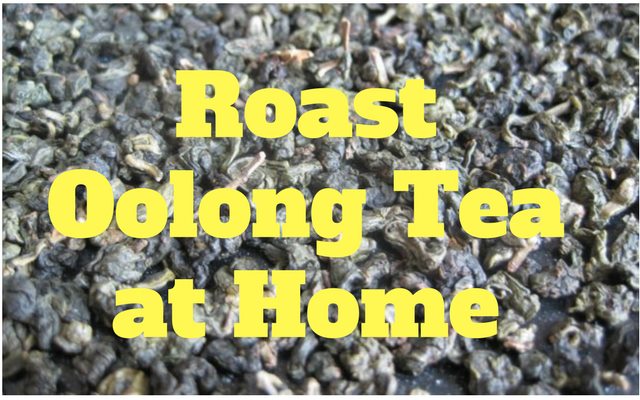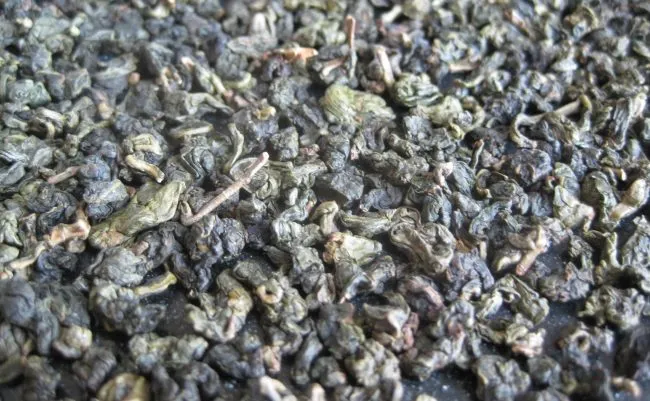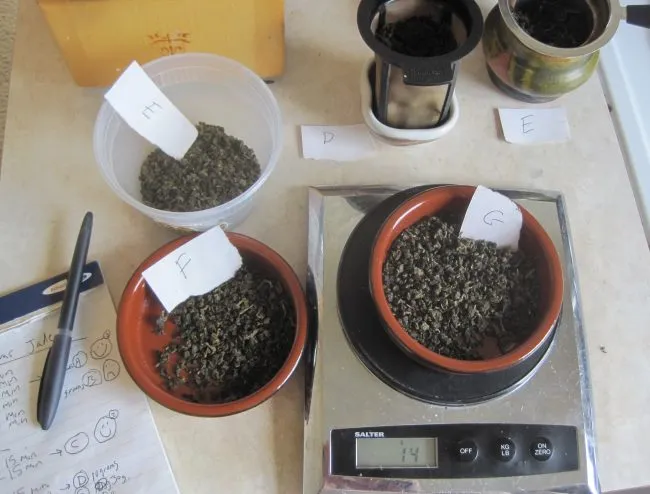
Many coffee drinkers like roasted oolong tea. It shares some characteristics with coffee, such as nuttiness and a rich body. And just like coffee, how long the tea is roasted greatly influences its taste. Last year, I decided to experiment with roasting my own oolong tea. After all, I’ve been home roasting coffee since 1998.
Why not roast tea as well?
Before we dive into the roasting, let me cover what oolong tea is for those who might only be familiar with green and black teas. A simple definition is that green tea is a tea that has not been oxidized (0%), whereas black tea is a tea that has been fully oxidized (100%). Oolong tea represents the middle ground, otherwise known as semi-oxidized tea. The Tea Processing page on Wikipedia states:
This tea’s oxidation is stopped somewhere between the standards for green tea and black tea. The processing typically takes two to three days from withering to drying with a relatively short oxidation period of several hours.
The oxidation percentage of oolong tea can be low or high. The lower oxidized teas tend to be brighter, and the higher oxidized ones have a richer body, which is closer to black teas. Many tea drinkers, myself included, gravitate towards oolongs. We love the flavors and fragrances typically not found in green and black teas. That is the basic explanation of oolongs. I’ve added links in the reference section below for those wishing to learn more.

Oolong Tea
To Refresh, To Roast
Oolong teas like other perishable items can go stale over time and lose flavor. Tea can also absorb the odors that surround them if stored improperly. If a tea started with a good flavor and has gone flat, a short lower temperature roast can bring it back to life. This is called refreshing the tea.
Although each tea will vary depending on age and oxidation level, a basic refresh recipe is roasting it in the oven at 200 F for 20 minutes. I learned that as wonderful as the refresh technique is, you can’t bring back to life a tea that is too stale or never had a great flavor to begin with.
Once the refresh portion is complete, you can proceed to the roast. This involves slowly increasing the temperature. How long you roast the tea is up to you. If you like the “roasty” flavor, take the roast longer. I like to find the balance between the bright characteristics of the oolong and the toasty flavors that develop during the roast.
Time to Roast Some Oolong Tea
To roast oolong tea at home, you only need an oven, a cookie sheet, and some oolong tea. To get started, I recommend using a lighter, affordable oolong, such as a Jade oolong. Starting from something light and bright and moving toward a darker, toastier tea will highlight the differences you will get during the roasting process. It is perfectly acceptable to pull out tea at different points and brew it up during the roast. I encourage you to do that.
During the roast, I will pull the tea out of the oven a few times and stir it so the roasting is even.
A typical oolong roast profile will start at a low temperature and gradually increase. If you have experience home roasting coffee, my advice is to relax and be patient. Roasting tea takes much longer than coffee. When I first started roasting, I focused too much on creating an optimal temperature profile. Because every tea is different, it is better to learn to focus on color and smell. By the way, the smell of roasting oolong tea is amazing. Pull samples during the roast and brew. You’ll learn quickly how roasty you like your tea, and if you under-roast something, you can always roast it longer later.
Step
Temp F
Minutes
Profile
1
200
20
2
225
15
3
240
15
4
265
15
A
5
275
15
B
6
285
15
C
In the table above, I used three roast profiles (A, B, and C) for my Jade Oolong. Your times will most likely differ depending on the oolong you roast, your oven, and your personal taste preference. Using the table is to start at the first row and work down the table, adjusting the temperature for the specified time. With each step, the temperature is increased. Don’t forget to pull the tea out of the oven and stir periodically. This will ensure the roast is even.

This was my setup for determining tea roast profiles.
Final Words
Like home coffee roasting, you can buy a dedicated tea roaster to explore this hobby. I know some tea shops that have their mini bamboo tea roasters. They do better than oven roasting, but a cookie sheet is fine if you roast small batches of tea. The mini tea roasters are best for larger volumes done at tea shops.
Coffee is still our first love at INeedCoffee, but many of us love our sister beverage almost as much.

3 oolong roast levels
Resources
What is Oxidation? – Article by Tony Gebely explaining tea oxidation.
Oolong – The Wikipedia page on Oolong tea does an excellent job highlighting the different types of oolongs and their different fragrances.
Tea Processing – Wikipedia page.
Miro Tea—While experimenting with roasting oolong, I received guidance from my local tea shop, Miro Tea. They hosted a few tastings of my roasts, and I used the tasting notes to improve my roast profiles.